Outlook for the domestic economy
The forecasts for the domestic economy are underpinned by several technical assumptions. The exchange rate is assumed to remain around levels observed at the time of writing (a trade-weighted index of around 64 and a $US exchange rate of around 80c). Interest rates are assumed to remain broadly flat, in line with market expectations. World oil prices (Tapis) are assumed to remain at around $US 72 per barrel. The farm sector forecasts are based on an assumed return to average seasonal conditions over the forecasting period.
Household consumption
While still weak, the outlook for household consumption has strengthened since Budget. Consumer confidence has been bolstered following recent deep cuts to mortgage interest rates and the Government's Economic Security Strategy and the Nation Building and Jobs Plan (NBJP), which have add around $19.7 billion to household incomes.
Following an earlier fall of around 50 per cent in share market values and a moderate fall in house prices, these markets have stabilised in recent months arresting the sharp declines in household wealth. This has also improved consumer confidence.
Household consumption grew by a solid 0.6 per cent in the March quarter while the December quarter outcome was revised up slightly. Retail sales figures for April suggest consumption spending will remain around current levels in the June quarter.
Nonetheless, the continuing impact of the global recession, rising unemployment and previous falls in wealth are expected to weigh on consumption growth over the forecast horizon. Consumption will also weaken as the effects of temporary cash payments subside.
Forecasts for household consumption in 2009-10 have been revised up from a ¼ per cent decline at Budget to growth of ¼ per cent.
Household consumption is expected to grow by 2 per cent in 2010-11, up from 1 ¾ per cent at Budget.
Chart 1: Real consumption
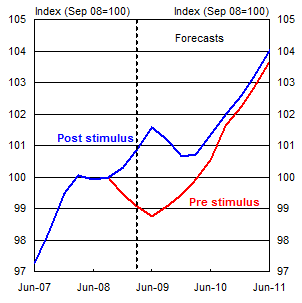
Source: ABS Catalogue Number 5206.0 and Treasury.
Households have been rebuilding saving in response to sharp declines in household wealth. The household saving ratio spiked in the December quarter following the initial ESS payments. It fell back in the March quarter but is again expected to spike in the June quarter when the majority of the NBJP payments are made.
Chart 2: Household saving ratio
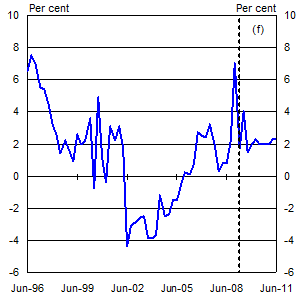
Source: ABS Catalogue Number 5206.0 and Treasury.
Dwelling investment
Dwelling investment is showing signs of a recovery towards the end of the year with support from lower interest rates and the First Home Owners Boost. The forecasts are largely unchanged from Budget although the timing of the recovery has been brought forward a little.
New dwelling investment is now expected to fall by 1½ per cent in 2009-10 compared to a 4 per cent fall in the Budget. Investment in alterations and additions is expected to grow by 2½ per cent in 2009-10.
New dwelling investment and alterations and additions fell broadly in line with Budget forecasts in the December and March quarters of 2008-09. While building approvals in the March quarter 2009 hit their lowest level since June 2001, more recent leading indicators suggest the sector may have troughed. Housing finance for constructing new dwellings and building approvals point to the start of a recovery in new dwelling investment towards the end of 2009.
Fundamentals in the sector remain strong. Low mortgage interest rates, robust population growth and high rental yields, are all pointing towards a moderate recovery towards the end of 2009 that gathers pace into 2010-11.
Chart 3: Dwelling investment (real)
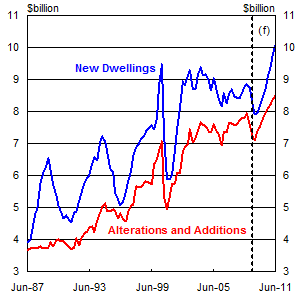
Source: ABS Catalogue Number 5206.0 and Treasury.
Recent house prices measures suggest that house prices have stabilised in early 2009 after falling only moderately over 2008. House prices are assumed to remain at close to their current levels over 2009-10. There is some uncertainty regarding future movements in house prices which is a key risk to the forecasts.
The Budget forecast of continuing strong growth in dwelling investment over 2010-11 remains unchanged, with forecast growth of 15 per cent in new dwellings, reflecting a strong underlying demand for new residential buildings and 8½ per cent growth in alterations and additions. The positive fundamentals are assumed to support house prices over the forecast horizon.
The risks identified at the time of the Budget are still present. Tighter credit conditions constraining activity particularly in medium density dwellings and a potential for further weakness in sentiment due to a rise of unemployment could impact on house prices and investment.
Business investment
New business investment is expected to increase by 4 per cent in 2008-09. However, the weak global and domestic economic outlook is expected to lead to a significant deterioration in business investment over the forecast horizon, with a fall of 17 per cent expected in 2009-10 before a modest recovery of 3 per cent in 2010-11, marginally stronger than at Budget.
Business conditions and sentiment appear to have stabilised, albeit at low levels, over recent months in contrast to the sharp falls experienced in late 2008 and early 2009. Despite this, the majority of business surveys have consistently shown weaker investment intentions over the next year, particularly in the industries outside the mining sector. The marginally improved forecasts for 2009-10 reflect the stabilisation of business conditions and an industry perception that the outlook may not significantly deteriorate further.
Chart 4: Business investment to GDP ratio (nominal)
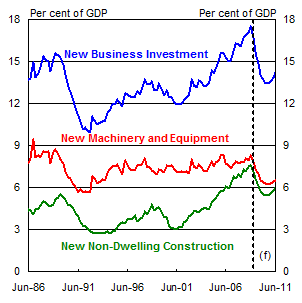
Source: ABS Cat. No. 5206.0 and Treasury.
Investment in new machinery and equipment is slightly weaker than the Budget forecasts as the result of a weaker CAPEX result. Investment is expected to increase by 1½ per cent in 2008-09, followed by a decrease of 17½ per cent in 2009-10. A modest recovery is expected to commence in 2010-11.
The second estimate of CAPEX investment intentions for 2009-10 implies negative investment growth with particular weakness in the construction, wholesale and transport and storage sectors. In 2010-11, investment in new machinery and equipment is expected to grow by 4 per cent, as corporate profits improve following a recovery in domestic and world economies.
New engineering construction investment is expected to increase by 11½ per cent in 2008-09, followed by a decrease of 15 per cent in 2009-10 before growing by 5 per cent in 2010-11. The forecasts for 2008-09 are stronger than Budget forecasts, reflecting a stronger-than-expected outcome for the March quarter, as well as an upward revision to the December quarter, and the pipeline of existing work flowing through to investment in the next few quarters. The recovery in 2010-11 is based on an expectation of a few high value projects in the oil and gas sector commencing work later in 2010.
Significant projects that are expected to commence in the forecast period include Gorgon Joint Venture, Inpex Alpha LNG Ichthys, and Woodside LNG Browse Basin. However, there remains a significant risk of delays or cancellations to mining projects in light of
lower commodity prices and to projects that are facing difficulty in securing financing.
Non-residential buildings investment is expected to fall by 1 per cent in 2008-09 and by 27 per cent in 2009-10. The fall in investment is expected to be less abrupt but more protracted than at Budget as a result of some momentum from current projects and a slight improvement in approvals during the March quarter 2009. However, tighter credit conditions, increasing unemployment and weaker consumption are expected to weigh heavily on activity particularly in the office, warehouse and retail markets.
Public final demand
New public final demand is expected to increase by 7½ per cent in 2009-10 and fall by 1¾ per cent in 2010-11. The forecasts are little changed from Budget and are driven by the stimulus packages announced since October last year.
Total new public investment is expected to grow by 22½ per cent in 2009-10, the largest increase on record. Very strong State and Local investment and solid Commonwealth investment are driving the growth. However, slippage in public spending remains a risk.
Chart 5: Nominal public expenditure
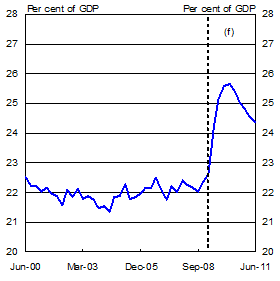
Source: ABS Catalogue Number 5206.0 and Treasury.
Exports, imports and the current account deficit
The forecast for the trade balance is unchanged from Budget in 2009-10. A widening in the trade deficit is expected in 2010-11, as domestic demand for imports strengthens ahead of a recovery in global demand.
Net exports are expected to contribute ½ of a percentage point to GDP growth in 2009-10 due to a significant fall in import volumes as the domestic economy weakens, though this is partially offset by a fall in export volumes. Net exports are expected to detract ½ of a percentage point from growth in 2010-11 as import volumes recover more quickly than export volumes.
Exports represent a potential weakness looking forward. However, substantial falls in exports have not yet eventuated, with exports holding up relatively well in the March quarter. Additionally, stronger demand from China could present some upside risk to our non-rural commodity export forecasts.
Chart 6: Export growth comparison
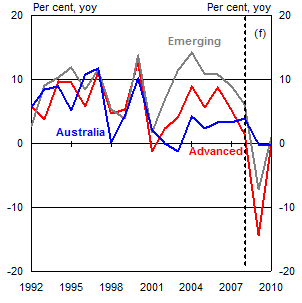
Source: IMF and Treasury.
Export volumes are expected to be stronger than forecast at Budget, falling by 2½ per cent as global demand contracts. Modest growth of 4 per cent is expected in 2010-11, reflecting a recovery in the global economy.
Non-rural commodities are now expected to grow by 5 per cent in 2008-09 and fall by 3 per cent in 2009-10. Volumes are still expected to recover strongly in 2010-11.
The collapse in global demand for raw materials has been sudden and dramatic, and producers have cut production sharply. Expected demand from key coal markets such as South Korea, Japan and Taiwan continues to be revised downwards. In contrast to this, Chinese commodity demand has continued to hold up, driven by inventory restocking and demand related to the Chinese government's stimulus package. Furthermore, lower prices and safety issues have induced some Chinese iron ore and coal mines to close, leading some Chinese steel producers to switch to lower-cost Australian coal and iron ore.
Chart 7: Import/Export contribution
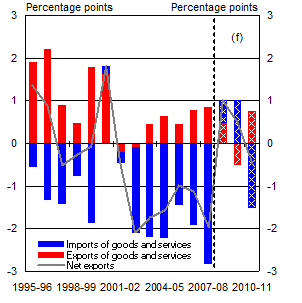
Source: ABS Catalogue Numbers 5206.0 , 5302.0 and Treasury.
Farm production is expected to increase by 17 per cent in 2008-09, higher than at Budget due to an estimated larger crop harvest. Summer crop production in 2008-09 is estimated to be higher than the Budget forecast. This will flow through to rural exports, which are expected to grow by 10 per cent in 2008-09.
Lower world growth and a higher Australian dollar are expected to weigh on elaborately transformed manufactures (ETM) and services exports. ETM exports are expected to contract by 10 per cent in 2009-10, a more severe contraction than forecast at Budget. A particularly acute decline for car exports is driving this outcome.
Services exports are forecast to fall by 4½ per cent in 2009-10, unchanged from the budget forecast. A moderate recovery in both ETMs and services is anticipated in 2010-11 as global demand strengthens.
Imports of goods and services are expected to fall by 4½ per cent in 2009-10. This is slightly higher than forecast at Budget, reflecting a stronger forecast for domestic demand. Imports are expected to increase by 6½ per cent in 2010-11.
The terms of trade are forecast to decrease by 12½ per cent in 2009-10, a smaller fall than at Budget. Recent contract negotiations indicate that contract prices for the major bulk commodities have fallen in line with Budget expectations. Other non-rural prices are expected to fall slightly more than at Budget, reflecting the weaker world outlook and the higher exchange rate. Rural export prices are forecast to fall further than at Budget in 2009-10, due to weaker global demand and a stronger Australian dollar.
Import prices are also expected to be lower, in part due to declining world inflation for manufactured goods. The terms of trade are assumed to be flat in 2010-11, but the difficulty in forecasting commodity prices out this far means there remains the risk of further changes in commodity prices in either direction.
Chart 8: Terms of trade
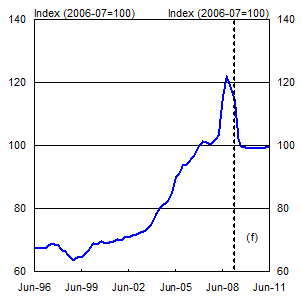
Source: ABS Catalogue Number 5302.0 and Treasury.
The forecast for the current account deficit (CAD) has narrowed since Budget, at 4¾ per cent of GDP in 2009-10, and to 5¼ per cent in 2010-11. This reflects an expected rise in both the net income deficit (NID) and trade deficit. From a savings and investment perspective, gross investment is forecast to decline as a share of GDP over the forecast horizon, before picking up slightly in 2010-11. The forecast for gross savings shows a rise in 2008-09 as households rebuild savings, before declining in 2009-10 as corporate savings fall in line with reduced profitability. The public sector is expected to move further into a significant deficit position.
Chart 9: Current account balance
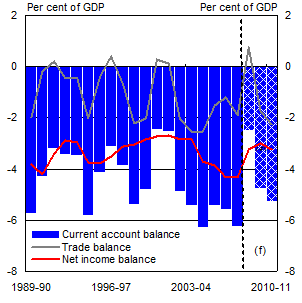
Source: ABS Catalogue Numbers 5206.0, 5302.0 and Treasury